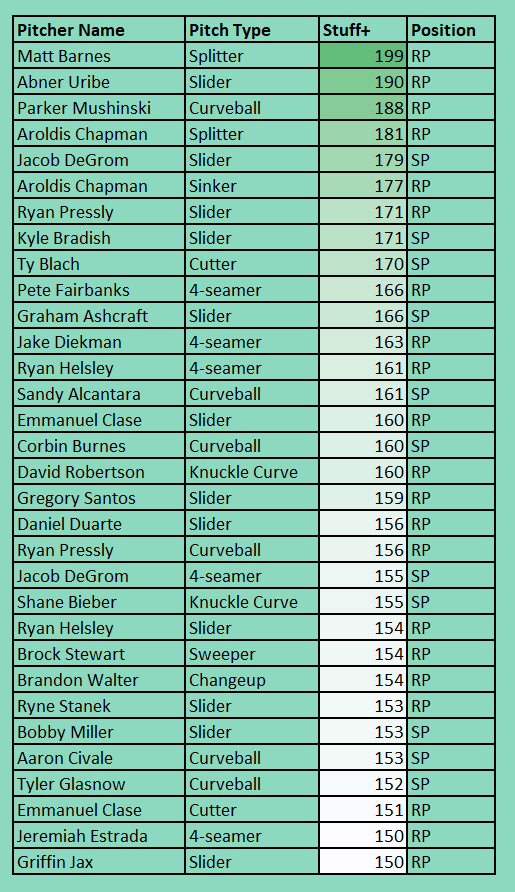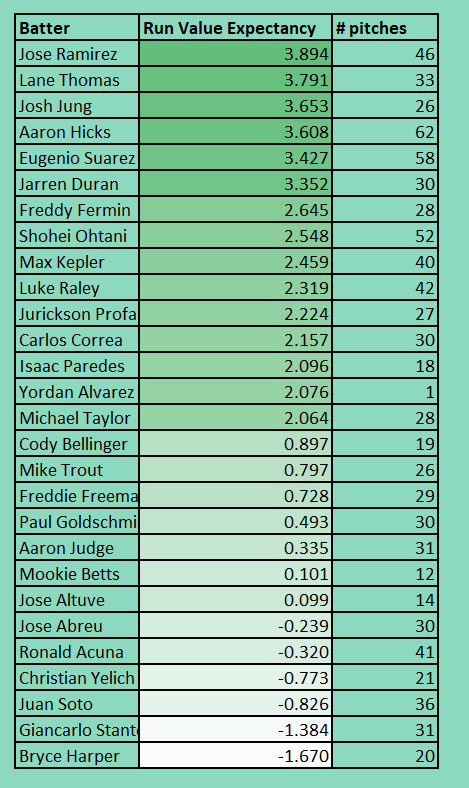Which Batters Can Produce Against the Nastiest Pitches?
Photo Credit: The Daytona Beach News-Journal
Watching the MLB playoffs this year, I started to think about identifying hitters that have the pitch recognition and bat-to-ball skills to make positive contributions against the league’s best pitching. To investigate this, I started off by looking at pitch location, specifically Heart, Shadow, Chase and Waste, as defined by Baseball Savant.
It makes sense to me that playoff-level pitching would likely target the Shadow and Chase areas consistently, steering clear of the Heart and Waste zones. This insight allows me to adjust the Swing/Take Run Values of each hitter accordingly and come up with a combined Run Value that better reflects a batter's performance against playoff-caliber pitching.
Before I delve deeper into the pitch location differences between the regular season and the playoffs, let’s take a look at how the league’s top hitters produced against each pitch region, illustrated in Table 1 through Table 5 below.
Table 1: Savant Total Run Values
Table 2: Savant Run Values (ranked by Heart)
Table 3: Savant Run Values (ranked by Shadow)
Table 4: Savant Run Values (ranked by Chase)
Table 5: Savant Run Values (ranked by Waste)
As evident from the tables, Ronald Acuna Jr. stands out, leading the majors in overall Run Value, yet his performance in the Shadow region was only slightly above average. Moreover, Corey Seager and Aaron Judge excel at hitting pitches down the heart of the plate, but both fall short in their productivity within the Shadow region.
On the other hand, Nolan Jones, Yordan Alvarez, Luis Arraez, Shohei Ohtani, Freddie Freeman, and Mookie Betts consistently deliver in the Shadow region, making it challenging for pitchers to find a reliable way to get them out. Meanwhile, Matt Olson, Juan Soto, Alex Bregman, and Kyle Schwarber showcase remarkable discipline by seldom chasing pitches in the Chase region. Joining them, Kyle Schwarber and Max Muncy exhibit exceptional patience, particularly in the Waste region.
Pitch breakdown in the regular season versus the playoffs
As evident from Table 6, the pitch region breakdown in the playoffs is nearly identical to that of the regular season, with playoff pitchers able to reduce their percentage of pitchers in the Heart region by 1% in and increase their percentage of pitches in the Chase region by 1%.
Hence, I limited the scope of the analysis to the combination of velocity, spin rate, movement, and extension of pitches, defined as Stuff+, rather than pitch locations.
Table 6: 2023 pitch region breakdown in the regular season and playoffs
Who can be categorized as having nasty pitches?
I collected and grouped the 10,000+ pitches from 2023 that were graded as the nastiest, on average by Stuff+, and sorted them by batter, summing up the Run Value added on each pitch. Table 7 below has the nastiest pitcher/pitch combinations in 2023.
Table 7: Pitches that are graded as at least 50% nastier than the average pitch with a minimum of 20 pitches thrown in 2023.
Batter performance against the nastiest pitches in 2023
Table 8 lists all the batters with a cumulative Run Value of over 2 runs against the league’s nastiest pitches in 2023, with a minimum of 15 nasty pitches faced.
Jose Ramirez tops the list and is joined by superstar Shohei Ohtani in the top 10.
All the batters with a cumulative Run Value of 2 or more have shown either an exceptional ability to recognize and take nasty pitches that end up outside of the strike zone, or extremely good bat to ball skills against high velocity and sharp breaking pitches.
Every MVP since the 2017 season, along with sluggers Yordan Alvarez and Juan Soto, was added to the table as honorable mentions. Interestingly, Alvarez only faced one of these nasty pitches all season.
Cody Bellinger, Mike Trout, Freddie Freeman, Paul Goldschmidt, Aaron Judge, Mookie Betts, and Jose Altuve were all able to contribute positively against the league’s nastiest pitches. However, Jose Abreu, Ronald Acuna Jr, Christian Yelich, Soto, Giancarlo Stanton, and Bryce Harper were not.
Table 8: Batter performance against the nastiest pitches in 2023. The league’s cumulative Run Value against these pitches was -69 runs (-0.689 runs/100 pitches).








